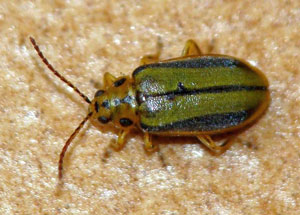Elm Leaf Beetles Are a Recurring Problem
By Chris Williams on April 30, 2013.
 Question
Question
Every spring we get these bugs in our house. The Extension Service says they are elm leaf beetles. Do you know why they are getting into our house and where they are coming from?
Answer
I don’t believe that the beetles are getting into your house in the spring. They have probably been in your house since last fall and are now looking to get back outside. Elm leaf beetles, like Asian lady beetles and stink bugs, are outdoor insects that occasionally become home invaders. In the fall, they leave their plant hosts and look for protected places to spend the winter. As for where they are coming from, you almost certainly have an elm tree or a zelkova tree in your yard that is the source of the beetles. Of course the tree could be in your neighbor’s yard, but these beetles don’t usually travel too far from their host tree.
The yellow to olive-green and black adult beetles become active again in May as the elm trees are leafing out. In your case, that means that they are trying to find a way out of your house. Females return to the elm tree where they lay eggs. The hatching larvae will feed on elm leaves for several weeks before pupating.
Both the adult beetle and the larval stage feed on elms. Of course, we have very few American elms left in the U.S., but these beetles actually prefer Siberian elms. They also feed on English and Chinese elms, as well as zelkova. The larvae feed on the underside of the leaf so you have to turn the leaf over to see them. But it’s hard to miss the shot holes that adults and larvae chew in the leaves. In heavy feeding, the leaf is completely skeletonized with only the ribs remaining.
When elm leaf beetle larvae are fully mature, they migrate to the base of the tree where they pupate in duff and leaf litter, or underneath bark. In some regions, the adults that emerge begin a second generation with more larval and adult feeding. By late summer, the adult beetles look for places to spend the winter. They will overwinter in any protected place they can find: under bark, in wood or leaf piles, in mulch, or under siding. If they can find their way inside, they end up in attics, behind baseboards or drapes, under carpets, and inside wall voids.
Elm leaf beetle feeding usually does no permanent damage to the tree. Heavy feeding causes the leaves to crisp up, turn brown, and drop prematurely. Infested trees may put out a new flush of growth which is also attacked. Elm leaf beetle feeding year after year can weaken a tree so that it succumbs to attacks by other insects, disease, or drought. Fortunately that doesn’t usually happen since elm leaf beetle populations fluctuate greatly from year to year.
How to Control Elm Leaf Beetles
Elm leaf beetles are controlled by having a professional power-spray the foliage on affected trees. Sprays are timed to kill the newly hatched larvae. In areas where there is a second generation in the summer, two larval sprays will be needed. You can also spray or dust a pesticide around the base of the tree to kill the larvae as they move down to pupate. Again, though, timing is critical.
You can also have a pest control company apply a perimeter treatment around your home in late summer to intercept the beetles as they try to move inside. Once the adult beetles have dispersed and moved indoors in the fall, it’s difficult to control them since they are hidden in so many different places. At Colonial, we offer a semi-annual exterior perimeter service that will block elm leaf beetles and other insects from entering your home. We also offer a pest exclusion service that will seal openings that insects use to get into your home. Give us a call today.
Photo credit: Valter Jacinto | Portugal / Foter.com / CC BY-NC-SA
Sign up for our biweekly email newsletter for more information about bugs and pests!